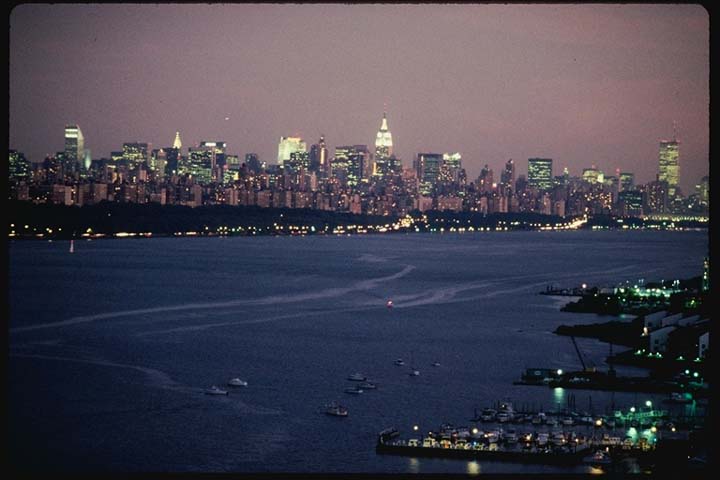- Hudson River
-
a river in the US state of New York. It flows 315 miles (510 kilometres) from the Adirondack Mountains to New York City where it joins the Atlantic Ocean. In 1825, it was connected to the Great Lakes by the Erie Canal. The river is named after Henry Hudson who in 1609 was one of the first people to travel along its unknown areas.

* * *
River, New York, U.S. Originating in the Adirondack Mountains and flowing for about 315 mi (507 km) to New York City, it was named for Henry Hudson, who explored it in 1609.Dutch settlement of the Hudson valley began in 1629. The river became a strategic waterway during the American Revolution and was the scene of many battles. Linked by canals with the Great Lakes and with the Delaware River and lower St. Lawrence River valleys, the Hudson is now a major commercial route; its southern end forms the New York–New Jersey boundary.* * *
river in New York state, U.S. It flows almost entirely within the state, the exception being its final segment, where it forms the boundary between New York and New Jersey for 21 miles (34 km). The Hudson originates in several small postglacial lakes in the Adirondack Mountains near Mount Marcy (Marcy, Mount) (5,344 feet [1,629 metres]), the highest point in New York, and flows about 315 miles (507 km) through the eastern part of the state. Lake Tear of the Clouds is regarded as the source of its main headstream, the Opalescent River.The Hudson follows a winding course for its first 108 miles (174 km), flowing generally southeast to Corinth in Saratoga county and then northeast to Hudson Falls. From there it flows (without significant gradient) almost directly south for 200 miles (320 km) to the Battery at the head of Upper New York Bay (at New York City). It drains an area of 13,370 square miles (34,628 square km). Its lower course, about 150 miles (240 km) long, occupies a drowned valley; extending seaward from its mouth for about 200 miles is a deep submarine canyon. Tides are felt as far north as the federal dam at Troy, where the mean tidal range is 4.7 feet (1.4 metres). The river reaches its widest point—3 miles (5 km)—at Haverstraw Bay (between Westchester and Rockland counties) before narrowing again to 0.75 mile (1.2 km) at its mouth. Together with the Mohawk River, its major tributary, it forms one of the nation's most important waterways.The river was known to the Mahican (Mohican) (Mohican) Indians as Muhheakunnuk (“Great Waters Constantly in Motion”). The Florentine navigator Giovanni da Verrazano (Verrazzano, Giovanni da) sailed a short distance upstream in 1524, but the river came to bear the name of the Englishman Henry Hudson (Hudson, Henry), who explored it in 1609. Dutch settlement of the Hudson valley began in 1629, and the serene beauty of the region near Tarrytown formed a background for the stories of Washington Irving (Irving, Washington) and inspired the Hudson River school of landscape painting and architecture. A strategic waterway during the American Revolution, the Hudson was the scene of numerous battles, including the decisive American victory at Saratoga and the naval battle of Tappan Zee. Benedict Arnold (Arnold, Benedict), the American military commander of forts in the Tappan Zee area, escaped to a British ship anchored near the village of Garrison after his discovery as a traitor. George Washington (Washington, George) made his headquarters at Newburgh, along the west bank, in 1782 and later disbanded the American armies from there. The Palisades (Palisades, The) extend southward along the river's west bank from southern New York into northern New Jersey. The river is overlooked at West Point by the U.S. Military Academy (United States Military Academy) and at Hyde Park by the home of President Franklin D. Roosevelt (Roosevelt, Franklin D.).The opening of three canals during the 19th century (the Erie (Erie Canal), the Delaware and Hudson, and the Champlain) linked the river with the Great Lakes and the Delaware (Delaware River) and lower St. Lawrence river valleys. It was thus a key factor in the growth of the Midwest as well as of New York City. Practical steam navigation was begun by inventor and engineer Robert Fulton (Fulton, Robert) in 1807, and the river quickly became a major commercial route. The main towns along its lower course owed their early prosperity to the whaling trade, and later in the 19th century they became home ports for interoceanic fleets.Navigational improvements began in 1797, and in 1892 the Hudson was declared a federal government waterway. Controlling depth is 27 feet (8 metres) at Albany and 14 feet (4 metres) from Albany north to the Mohawk River. The river is open and navigable to Albany year-round for oceangoing ships and from early May to mid-November to the Great Lakes (via the canalized Mohawk and the New York State Canal System) for pleasure-boat and tugboat-barge traffic. River-borne cargo includes wood pulp, steel, cocoa beans, grain, and scrap metal. Passenger traffic has been replaced by parallel rail and highway facilities. Numerous bridges cross the river, including (from north to south) the Castleton-on-Hudson (built 1959), the Rip Van Winkle (1935), the Newburgh-Beacon (1963), the Bear Mountain (1924), the Tappan Zee (1956), and the George Washington (1931). Vehicular and railway tunnels connect New York City to northern New Jersey.Pollution of the river by industrial waste and raw sewage has been a continuing problem. Conservation groups have made attempts to preserve the river's ecological values, and pure-water programs have been inaugurated by the state and local governments.* * *
Universalium. 2010.
